The history of "soft" (flexible) drives
Today, we use HDD, SSD, SD cards, USB flash drives to store information. Already much less often we insert laser disks into laptops. I personally have no devices at home supporting this carrier.
Many of us have not seen audio and video cassettes, reels with magnetic films, floppy disks, and especially punched cards and punched tapes for a long time. These carriers, some of which have been known since the 18th century, have almost disappeared.
But only almost. Today we will talk about the times when “soft” data carriers were in use, and that all of them are still alive thanks to their firm rooting in state and military institutions and research centers.
')
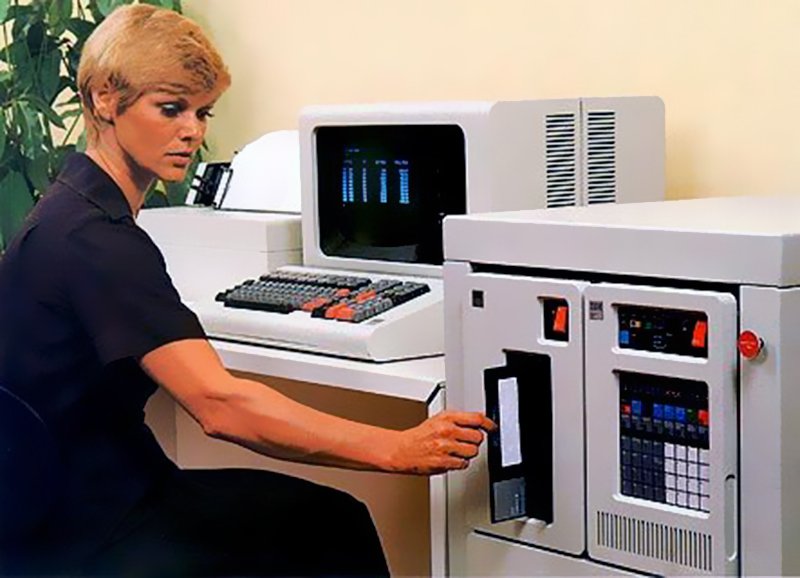
Punch cards, which we know as a way of storing and transmitting information for computers in the 1920s and 1950s, are rooted in pre-computer time. Namely - in 1725, when perforated paper began to be used to control the loom.
Basile Bouchon, the son of an organ collector, adapted the system used to automatically play music (“unwrapped” a cylinder with pins / cams) to the needs of weaving.
He used perforated roll paper to make the machine reproduce the pattern on the fabric. Bouchon's colleague, Jean-Baptist Falcon, replaced the paper tape with punched cards fastened together.

Basil Bouchon Loom
The mechanism improved Joseph Marie Jacquard. He created his loom for large-grain fabrics in 1804. Perforated cards allowed in the automatic mode, practically without the participation of the master, to carry out a certain alternation of raising and lowering the warp threads in order to display the given pattern on the fabric.

Perforated Cards in Jacquard Loom

The result of the work of the Jacquard machine
In the weaving business is still used Jacquard machines, improved, automated. But punch cards still work. Below you see an example of a punch card from a home economics website for a Brother machine - with a motorcyclist for a children's sweater.

Punch Card for Modern Brother Knitting Machine
Charles Babbage in 1822 built the first model of his differential machine, which consisted of rollers and gears, rotated with a special lever. Then he asked the British government to finance his further work. In the process, he faced many problems, so after nine years the work got up. Although partially the machine functioned and made calculations. Later he returned to work in the years 1847-1849. For this huge calculator, Babbage even developed a printer, which in 2000 was launched at the London Science Museum.
The main parts of the analytical machine were the “warehouse” for storing numbers, the “mill” for performing arithmetic operations, the device controlling operations, and input and output devices. Punch cards were used to enter data into memory: one mechanism with punch cards set operations to the “mill”, the second controlled the transfer of data between the “mill” and the “warehouse”. An output device, that is, a printer, could in one or two copies reproduce the result as a print or punch it on punch cards.

Punch Cards for Babbage Analytical Machine
In the same years, in the first half of the 19th century, Russian inventor Semen Korsakov worked on mechanical intellectual machines. He became one of the pioneers of the use of perforated cards in computer science. In 1832 he created his first device, functioning on the basis of perforated tables and intended for information retrieval and classification tasks. It was a homeoscope with fixed parts.
Each line of the homeoscope corresponds to a certain sign - the symptom of the disease. In the vertical column there was a set of signs - pathological symptoms, of which one or several characterized the disease. The bottom line contained a solution to the problem - a medicine that will help with the disease.
The homeoscope itself was a cylinder with pins. The operator chose the symptoms from the first column — for example, cough and runny nose — and pressed pins. Then he led the cylinder to the right on the table: when the cells were perforated in the right places, the homeoscope stopped, and in the bottom line one could read information about the treatment of the disease.
It was a kind of Excel-table (before spreadsheets), sharpened to the needs of the doctor.

Fixed parts homeoscope
Calculations of the US census in 1880 took eight years, and the 1890 census only a year. Such a difference is explained by the introduction of a punch card counting machine.
In the 1880s, inventor Herman Hollerith patented punch card equipment. His statistical tab allowed the census to be speeded up, after which Cholerit was promoted to professor at Columbia University.
The buyers of the tabulation machines TMC, Tabulating Machine Company, steel railway administrations and government agencies. In 1924, the company was renamed IBM - International Business Machines.

Hollerith Punch Card
IBM produced electric tabs on punch cards until 1976. The latest model was the IBM 407. Its rental cost from 800 US dollars per month - about 5,000 dollars for 2016.

Ibm 407

Punch card for language FORTRAN
In the USSR , the T-5M, T-5MU, T-5MV and TA80-1 tabulators were produced. The first three worked with digital information, and the fourth - from alphanumeric. To enter the information, 80-column and 45-column perforated cards were used. The tabs worked with the final, reading and reproduction perforators, with electronic computing and multiplying set-top boxes on the machine computing stations.

Tabulator T-5 MW at the machine metering station: Source

80-column Soviet-made punch card for IBM tabulator, 1980
In 1938, German engineer Konrad Zuse built one of the first programmable computers in the world - the Z1 . The machine had an input device in the form of a keyboard made of a typewriter, an electric drive, and was able to calculate data in the decimal system as floating-point numbers. The data was output using the panel on the lamps.
The machine performed the multiplication in 5 seconds. The clock frequency was 1 Hz. The system worked at the expense of a 1-kilowatt vacuum cleaner engine.
The Z1 was equipped with a punched tape reader, which provided an operation code for each instruction.

Konrad Zuse and Z1 computer recreated after World War II

Punched tape for computer Z1
In the 1940s, American gunners used firing tables containing information on sight corrections in accordance with the distances to the target. Calculations of the trajectories by one person for one type of gun and one projectile took more than two weeks. It was necessary to calculate about three thousand trajectories for a variety of combinations of parameters - air temperature, soil density, wind speed, and so on. A scientist at the University of Pennsylvania, John William Mockley, decided to use vacuum tubes as an elemental basis for an electronic differentiating machine. From this begins the story of ENIAC, and then its improved version - EDVAC.
ENIAC collected in 1945. The first task was the mathematical modeling of a thermonuclear super-bomb explosion according to the Ulam-Teller hypothesis. The task was so complicated that even with ignoring many physical effects and maximally simplifying the equation, it took a million punch cards to enter the program into the computer.
To read the punched cards used tabulator IBM. One of the problems of this data carrier was the low speed of work: it took too much time to perforate on the maps of the data extracted during the calculations and to enter them into the machine for further calculations. To solve this problem, the inventors began to work on new ways of entering and storing data - on magnetic tapes.

The first ENIAC programmers: squatting - Ruth Lichterman, worth - Marilyn Weskoff. 1946 A source

Reels clean punched tape Soviet-made. A source
In 1898, the Danish physicist and engineer Waldemar Poulsen patented a method of magnetic recording for wire. The device was called "telegraph". From the amplifier, the signal was fed to a recording head, along which the wire moved at a constant speed and magnetized according to the signal.
In 1927, German engineer Fritz Pfleimer sprayed iron oxide powder onto thin paper with glue, and a year later received a patent for the use of magnetic powder on paper or film. But the patent was revoked due to the fact that such an application of the powder was set forth in the Poulsen patent.
The ideas of Poulsen and Pfleimer were used by AEG, which developed the Magnetophone-K1 magnetic recording device. Magnetic tape for the "magnetophone" was made by chemical concern BASF. The device was presented at a radio exhibition in Berlin in 1935.

US patent for magnetic wire recorder. A source

"Magnetophone-K1"
In 1951, the inventors of the computer ENIAC John Eckert and John Mockley worked on a new machine. It was the first conventionally commercial computer in the United States - UNIVAC I. The computer was built for the needs of the Air Force and the US Army topographic service, and the order was placed on behalf of the Census Bureau. A total of forty-six copies of UNIVAC I were issued for installation in government offices, private corporations and universities. The second copy was installed in the Pentagon. The last copies were turned off in 1970 after 13 years of service in a commercial insurance company.
Car cost began with 159 000 dollars. Over time, the price ranged from 1,250,000 to 1,500,000 dollars. Translated into money in 2016, the maximum price of UNIVAC I was 12,480,000 dollars.
For the first time, magnetic tape was used as a data carrier in this computer. Up to ten UNISERVO tape drives could be connected at the same time.
UNISERVO became the first tape drive for a commercial computer and was a success. UNIVAC tapes of nickel-plated bronze were half an inch wide and up to 450 meters long. The data was recorded on eight tracks, where six were actually for the data, one for parity, and one for synchronization. One tape contained 1,440,000 six-bit characters.
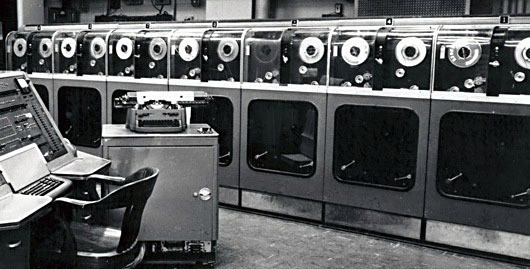
UNISERVO Tape Drives for UNIVAC
In 1960, IBM developed the first plastic card with a magnetic stripe. Bar codes and perforation did not differ in reliability, and for bank cards it was necessary to come up with a new way of storing data. The choice fell on a magnetic tape. Today, all bank cards have a magnetic tape, although they increasingly begin to use chips and NFC.
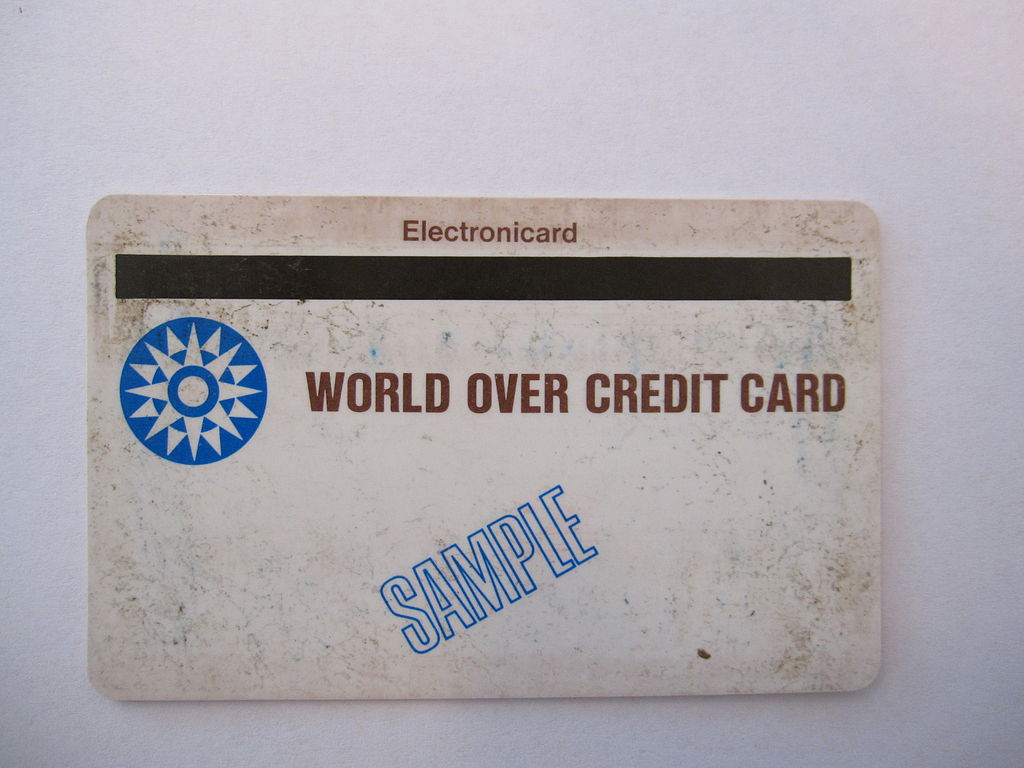
The first prototypes of magnetic stripe cards
Audio cassettes were often used to store information in personal computers from the 1970s and 1980s. Reproduction and recording of programs was carried out either with the help of special drives, or with the help of ordinary household audio recorders. Try to say out loud "audio recorder" - it sounds somehow unusual, right?

Sinclair ZX Spectrum + 2

Atari XC12 tape recorder for Atari 65XE and 130XE computers. A source
Many have already forgotten what audio tapes and video tapes look like. Someone never saw them and did not hold them in their hands. But for business and research centers, magnetic tapes are still of paramount importance.
CERN uses magnetic tape to store the results of the Large Hadron Collider operation , except for them clouds are combined with NASA magnetic tapes and Discovery TV channel. Large corporations also sometimes choose tapes. The advantage of the technology is the price - each gigabyte of storage costs from two to three cents. The speed of working with files is low due to sequential access - from several tens of seconds to a minute. But for data that does not require fast access, it is ideal. Up to 80% of corporate data can be written to tape, IBM is confident.
IBM continues to work on improving formats. In 2015, scientists from the company were able to record data on a magnetic tape with an efficiency of 123 billion bits per square inch. So they have exceeded in LTO-6 the format existing since 2012, according to which it is possible to record 2.5 TB of data on the film of the middle class. Earlier, in 2012, IBM, together with Fujifilm, began developing prototype cassettes of 10x10x2 centimeters, capable of storing up to 35 terabytes of data.
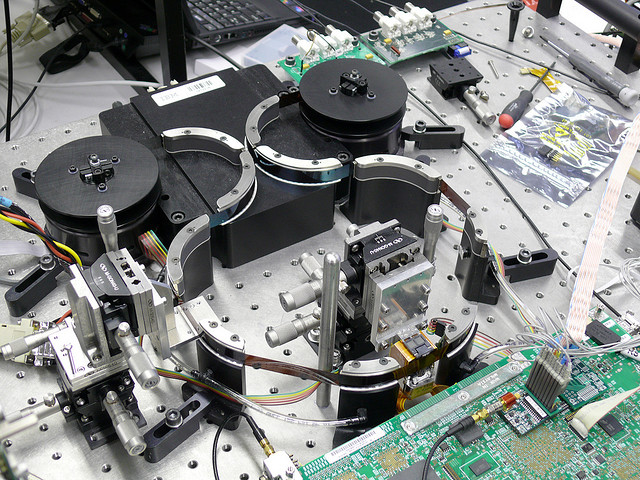
The main disadvantage of a magnetic tape is sequential access to data. This problem in the 1960s was solved by the team of Alan Shugart in the IBM laboratory. One of the senior engineers David Noble in 1967 proposed the use of a flexible magnetic disk with a protective casing. In 1971, the company introduced the first 8-inch diskette of 80 kilobytes and a drive for it.
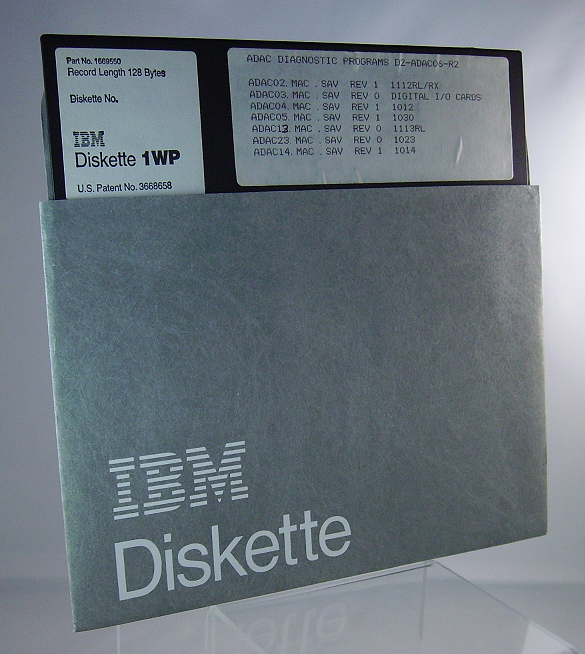
8-inch 128-kilobyte IBM diskette

Computer operator uses 8-inch floppy disk
Shugart in 1971 founded his own company Shugart Technology and in 1976 joined the development of mini-floppy disks for personal computers. The company released a floppy disk drive for 5¼-inch floppy disks that drove 8-inch floppy drives from the PC market.
In 1981, Sony released its own version of floppy disks, this time with a diameter of 3½ inches. They began to be used in computers HP, Macintosh, IBM, Atari, Commodore.
The first versions of floppy disks had a capacity of 720 kilobytes, in later floppy disks this figure was reduced to 1.44 megabytes. The result was improved by Toshiba, introducing a 2.88 megabyte drive in the 1980s. I remember only 1.44 megabyte floppy disks - because the format from Toshiba did not catch on .
Floppy advertising, 1986

External drive with usb interface

Three generations of floppy disks
Hitachi ceased diskette production in 2009. Sony covered the factories in 2010, after selling a total of forty-seven million floppy disks.
Toshiba in 2014 found a new use for its factory for the production of floppy disks: it converted it into a farm for growing lettuce, which does not need to be washed.

Toshiba vegetable farm - converted workshop for the production of floppy disks. A source
It would seem that the era of diskettes ended in December 2015, when the Norwegian government stopped distributing patient lists on diskettes. But it is not. In June 2016, we learned that MS-DOS-based medical software developed back in the 1980s continues to be used in hospitals in South Australia, and they use diskettes for data storage.
But here we are talking about 3½ floppy disks, a relatively modern version. At the same time, the US nuclear arsenal is controlled by 8-inch floppy disks! In the arsenal infrastructure, IBM Series / 1 was integrated in the 1970s, and these systems are still in operation. Systems plan to replace in 2017.
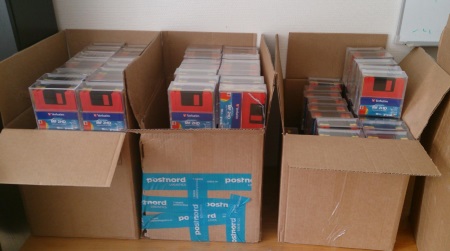
3.5 gigabytes of medical information on two and a half thousand floppy disks. Norway 2015
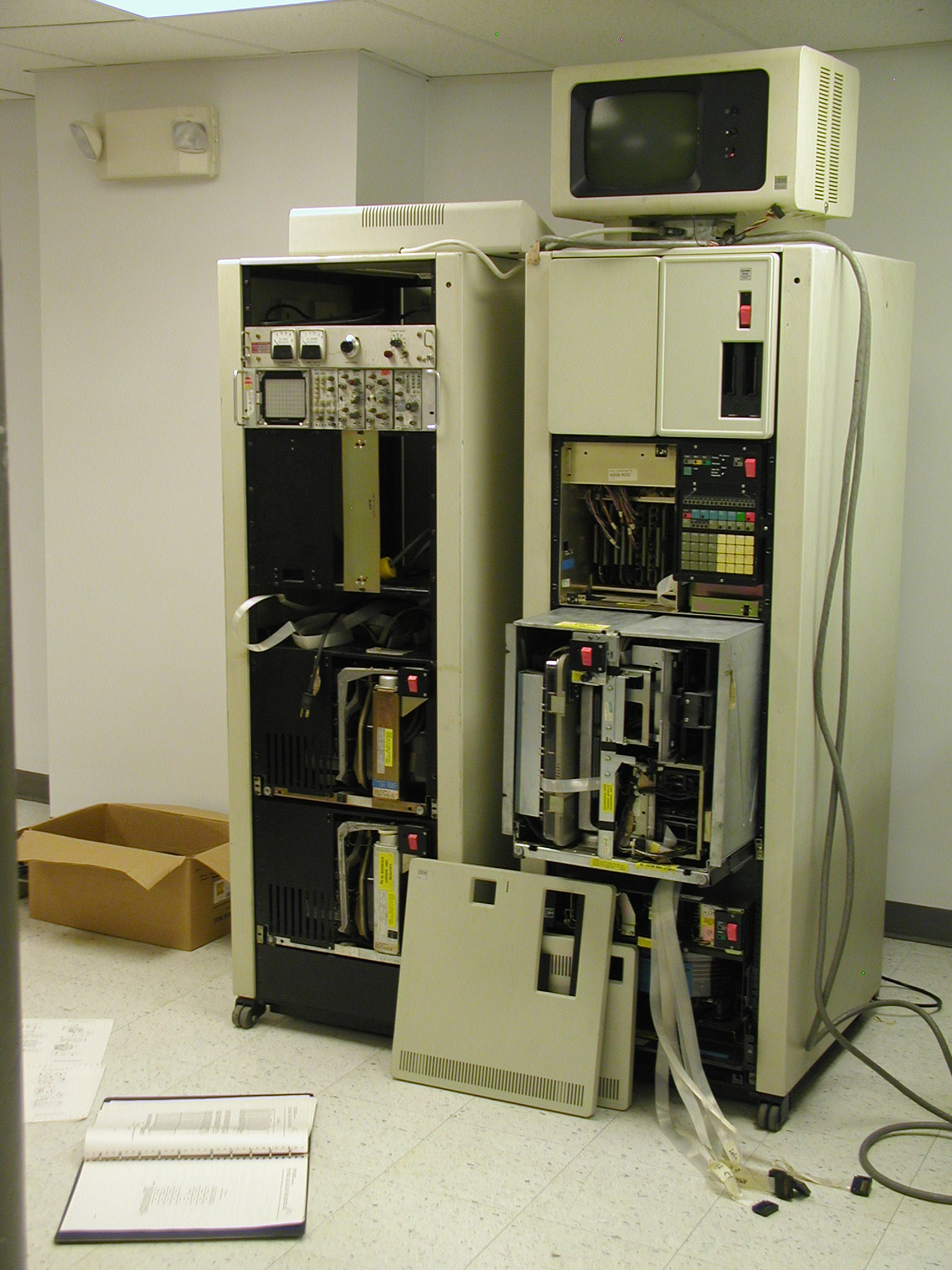
IBM Series / 1
Today, magnetic tapes, punch cards and floppy disks seem like yesterday afternoon. But they continue to use. Magnetic tapes make it cheaper to store data when using SSD and HDD. Floppy disks can not escape because of the tight integration in some institutions, for example, in the health system of some countries. And one of the very first carriers, the punch card, is still used with the same purpose for which it was created - in weaving and knitting machines.
Many of us have not seen audio and video cassettes, reels with magnetic films, floppy disks, and especially punched cards and punched tapes for a long time. These carriers, some of which have been known since the 18th century, have almost disappeared.
But only almost. Today we will talk about the times when “soft” data carriers were in use, and that all of them are still alive thanks to their firm rooting in state and military institutions and research centers.
')

Punched cards and punched tapes
Punch cards, which we know as a way of storing and transmitting information for computers in the 1920s and 1950s, are rooted in pre-computer time. Namely - in 1725, when perforated paper began to be used to control the loom.
Basile Bouchon, the son of an organ collector, adapted the system used to automatically play music (“unwrapped” a cylinder with pins / cams) to the needs of weaving.
He used perforated roll paper to make the machine reproduce the pattern on the fabric. Bouchon's colleague, Jean-Baptist Falcon, replaced the paper tape with punched cards fastened together.

Basil Bouchon Loom
The mechanism improved Joseph Marie Jacquard. He created his loom for large-grain fabrics in 1804. Perforated cards allowed in the automatic mode, practically without the participation of the master, to carry out a certain alternation of raising and lowering the warp threads in order to display the given pattern on the fabric.

Perforated Cards in Jacquard Loom

The result of the work of the Jacquard machine
In the weaving business is still used Jacquard machines, improved, automated. But punch cards still work. Below you see an example of a punch card from a home economics website for a Brother machine - with a motorcyclist for a children's sweater.

Punch Card for Modern Brother Knitting Machine
Charles Babbage in 1822 built the first model of his differential machine, which consisted of rollers and gears, rotated with a special lever. Then he asked the British government to finance his further work. In the process, he faced many problems, so after nine years the work got up. Although partially the machine functioned and made calculations. Later he returned to work in the years 1847-1849. For this huge calculator, Babbage even developed a printer, which in 2000 was launched at the London Science Museum.
The main parts of the analytical machine were the “warehouse” for storing numbers, the “mill” for performing arithmetic operations, the device controlling operations, and input and output devices. Punch cards were used to enter data into memory: one mechanism with punch cards set operations to the “mill”, the second controlled the transfer of data between the “mill” and the “warehouse”. An output device, that is, a printer, could in one or two copies reproduce the result as a print or punch it on punch cards.

Punch Cards for Babbage Analytical Machine
In the same years, in the first half of the 19th century, Russian inventor Semen Korsakov worked on mechanical intellectual machines. He became one of the pioneers of the use of perforated cards in computer science. In 1832 he created his first device, functioning on the basis of perforated tables and intended for information retrieval and classification tasks. It was a homeoscope with fixed parts.
Each line of the homeoscope corresponds to a certain sign - the symptom of the disease. In the vertical column there was a set of signs - pathological symptoms, of which one or several characterized the disease. The bottom line contained a solution to the problem - a medicine that will help with the disease.
The homeoscope itself was a cylinder with pins. The operator chose the symptoms from the first column — for example, cough and runny nose — and pressed pins. Then he led the cylinder to the right on the table: when the cells were perforated in the right places, the homeoscope stopped, and in the bottom line one could read information about the treatment of the disease.
It was a kind of Excel-table (before spreadsheets), sharpened to the needs of the doctor.

Fixed parts homeoscope
Calculations of the US census in 1880 took eight years, and the 1890 census only a year. Such a difference is explained by the introduction of a punch card counting machine.
In the 1880s, inventor Herman Hollerith patented punch card equipment. His statistical tab allowed the census to be speeded up, after which Cholerit was promoted to professor at Columbia University.
The buyers of the tabulation machines TMC, Tabulating Machine Company, steel railway administrations and government agencies. In 1924, the company was renamed IBM - International Business Machines.

Hollerith Punch Card
IBM produced electric tabs on punch cards until 1976. The latest model was the IBM 407. Its rental cost from 800 US dollars per month - about 5,000 dollars for 2016.

Ibm 407

Punch card for language FORTRAN
In the USSR , the T-5M, T-5MU, T-5MV and TA80-1 tabulators were produced. The first three worked with digital information, and the fourth - from alphanumeric. To enter the information, 80-column and 45-column perforated cards were used. The tabs worked with the final, reading and reproduction perforators, with electronic computing and multiplying set-top boxes on the machine computing stations.

Tabulator T-5 MW at the machine metering station: Source

80-column Soviet-made punch card for IBM tabulator, 1980
In 1938, German engineer Konrad Zuse built one of the first programmable computers in the world - the Z1 . The machine had an input device in the form of a keyboard made of a typewriter, an electric drive, and was able to calculate data in the decimal system as floating-point numbers. The data was output using the panel on the lamps.
The machine performed the multiplication in 5 seconds. The clock frequency was 1 Hz. The system worked at the expense of a 1-kilowatt vacuum cleaner engine.
The Z1 was equipped with a punched tape reader, which provided an operation code for each instruction.

Konrad Zuse and Z1 computer recreated after World War II

Punched tape for computer Z1
In the 1940s, American gunners used firing tables containing information on sight corrections in accordance with the distances to the target. Calculations of the trajectories by one person for one type of gun and one projectile took more than two weeks. It was necessary to calculate about three thousand trajectories for a variety of combinations of parameters - air temperature, soil density, wind speed, and so on. A scientist at the University of Pennsylvania, John William Mockley, decided to use vacuum tubes as an elemental basis for an electronic differentiating machine. From this begins the story of ENIAC, and then its improved version - EDVAC.
ENIAC collected in 1945. The first task was the mathematical modeling of a thermonuclear super-bomb explosion according to the Ulam-Teller hypothesis. The task was so complicated that even with ignoring many physical effects and maximally simplifying the equation, it took a million punch cards to enter the program into the computer.
To read the punched cards used tabulator IBM. One of the problems of this data carrier was the low speed of work: it took too much time to perforate on the maps of the data extracted during the calculations and to enter them into the machine for further calculations. To solve this problem, the inventors began to work on new ways of entering and storing data - on magnetic tapes.

The first ENIAC programmers: squatting - Ruth Lichterman, worth - Marilyn Weskoff. 1946 A source

Reels clean punched tape Soviet-made. A source
Magnetic tape
In 1898, the Danish physicist and engineer Waldemar Poulsen patented a method of magnetic recording for wire. The device was called "telegraph". From the amplifier, the signal was fed to a recording head, along which the wire moved at a constant speed and magnetized according to the signal.
In 1927, German engineer Fritz Pfleimer sprayed iron oxide powder onto thin paper with glue, and a year later received a patent for the use of magnetic powder on paper or film. But the patent was revoked due to the fact that such an application of the powder was set forth in the Poulsen patent.
The ideas of Poulsen and Pfleimer were used by AEG, which developed the Magnetophone-K1 magnetic recording device. Magnetic tape for the "magnetophone" was made by chemical concern BASF. The device was presented at a radio exhibition in Berlin in 1935.

US patent for magnetic wire recorder. A source

"Magnetophone-K1"
In 1951, the inventors of the computer ENIAC John Eckert and John Mockley worked on a new machine. It was the first conventionally commercial computer in the United States - UNIVAC I. The computer was built for the needs of the Air Force and the US Army topographic service, and the order was placed on behalf of the Census Bureau. A total of forty-six copies of UNIVAC I were issued for installation in government offices, private corporations and universities. The second copy was installed in the Pentagon. The last copies were turned off in 1970 after 13 years of service in a commercial insurance company.
Car cost began with 159 000 dollars. Over time, the price ranged from 1,250,000 to 1,500,000 dollars. Translated into money in 2016, the maximum price of UNIVAC I was 12,480,000 dollars.
For the first time, magnetic tape was used as a data carrier in this computer. Up to ten UNISERVO tape drives could be connected at the same time.
UNISERVO became the first tape drive for a commercial computer and was a success. UNIVAC tapes of nickel-plated bronze were half an inch wide and up to 450 meters long. The data was recorded on eight tracks, where six were actually for the data, one for parity, and one for synchronization. One tape contained 1,440,000 six-bit characters.

UNISERVO Tape Drives for UNIVAC
In 1960, IBM developed the first plastic card with a magnetic stripe. Bar codes and perforation did not differ in reliability, and for bank cards it was necessary to come up with a new way of storing data. The choice fell on a magnetic tape. Today, all bank cards have a magnetic tape, although they increasingly begin to use chips and NFC.

The first prototypes of magnetic stripe cards
Audio cassettes were often used to store information in personal computers from the 1970s and 1980s. Reproduction and recording of programs was carried out either with the help of special drives, or with the help of ordinary household audio recorders. Try to say out loud "audio recorder" - it sounds somehow unusual, right?

Sinclair ZX Spectrum + 2

Atari XC12 tape recorder for Atari 65XE and 130XE computers. A source
Many have already forgotten what audio tapes and video tapes look like. Someone never saw them and did not hold them in their hands. But for business and research centers, magnetic tapes are still of paramount importance.
CERN uses magnetic tape to store the results of the Large Hadron Collider operation , except for them clouds are combined with NASA magnetic tapes and Discovery TV channel. Large corporations also sometimes choose tapes. The advantage of the technology is the price - each gigabyte of storage costs from two to three cents. The speed of working with files is low due to sequential access - from several tens of seconds to a minute. But for data that does not require fast access, it is ideal. Up to 80% of corporate data can be written to tape, IBM is confident.
IBM continues to work on improving formats. In 2015, scientists from the company were able to record data on a magnetic tape with an efficiency of 123 billion bits per square inch. So they have exceeded in LTO-6 the format existing since 2012, according to which it is possible to record 2.5 TB of data on the film of the middle class. Earlier, in 2012, IBM, together with Fujifilm, began developing prototype cassettes of 10x10x2 centimeters, capable of storing up to 35 terabytes of data.

Floppy Disk
The main disadvantage of a magnetic tape is sequential access to data. This problem in the 1960s was solved by the team of Alan Shugart in the IBM laboratory. One of the senior engineers David Noble in 1967 proposed the use of a flexible magnetic disk with a protective casing. In 1971, the company introduced the first 8-inch diskette of 80 kilobytes and a drive for it.

8-inch 128-kilobyte IBM diskette

Computer operator uses 8-inch floppy disk
Shugart in 1971 founded his own company Shugart Technology and in 1976 joined the development of mini-floppy disks for personal computers. The company released a floppy disk drive for 5¼-inch floppy disks that drove 8-inch floppy drives from the PC market.
In 1981, Sony released its own version of floppy disks, this time with a diameter of 3½ inches. They began to be used in computers HP, Macintosh, IBM, Atari, Commodore.
The first versions of floppy disks had a capacity of 720 kilobytes, in later floppy disks this figure was reduced to 1.44 megabytes. The result was improved by Toshiba, introducing a 2.88 megabyte drive in the 1980s. I remember only 1.44 megabyte floppy disks - because the format from Toshiba did not catch on .
Floppy advertising, 1986

External drive with usb interface

Three generations of floppy disks
Hitachi ceased diskette production in 2009. Sony covered the factories in 2010, after selling a total of forty-seven million floppy disks.
Toshiba in 2014 found a new use for its factory for the production of floppy disks: it converted it into a farm for growing lettuce, which does not need to be washed.

Toshiba vegetable farm - converted workshop for the production of floppy disks. A source
It would seem that the era of diskettes ended in December 2015, when the Norwegian government stopped distributing patient lists on diskettes. But it is not. In June 2016, we learned that MS-DOS-based medical software developed back in the 1980s continues to be used in hospitals in South Australia, and they use diskettes for data storage.
But here we are talking about 3½ floppy disks, a relatively modern version. At the same time, the US nuclear arsenal is controlled by 8-inch floppy disks! In the arsenal infrastructure, IBM Series / 1 was integrated in the 1970s, and these systems are still in operation. Systems plan to replace in 2017.

3.5 gigabytes of medical information on two and a half thousand floppy disks. Norway 2015

IBM Series / 1
Today, magnetic tapes, punch cards and floppy disks seem like yesterday afternoon. But they continue to use. Magnetic tapes make it cheaper to store data when using SSD and HDD. Floppy disks can not escape because of the tight integration in some institutions, for example, in the health system of some countries. And one of the very first carriers, the punch card, is still used with the same purpose for which it was created - in weaving and knitting machines.
Source: https://habr.com/ru/post/372723/
All Articles